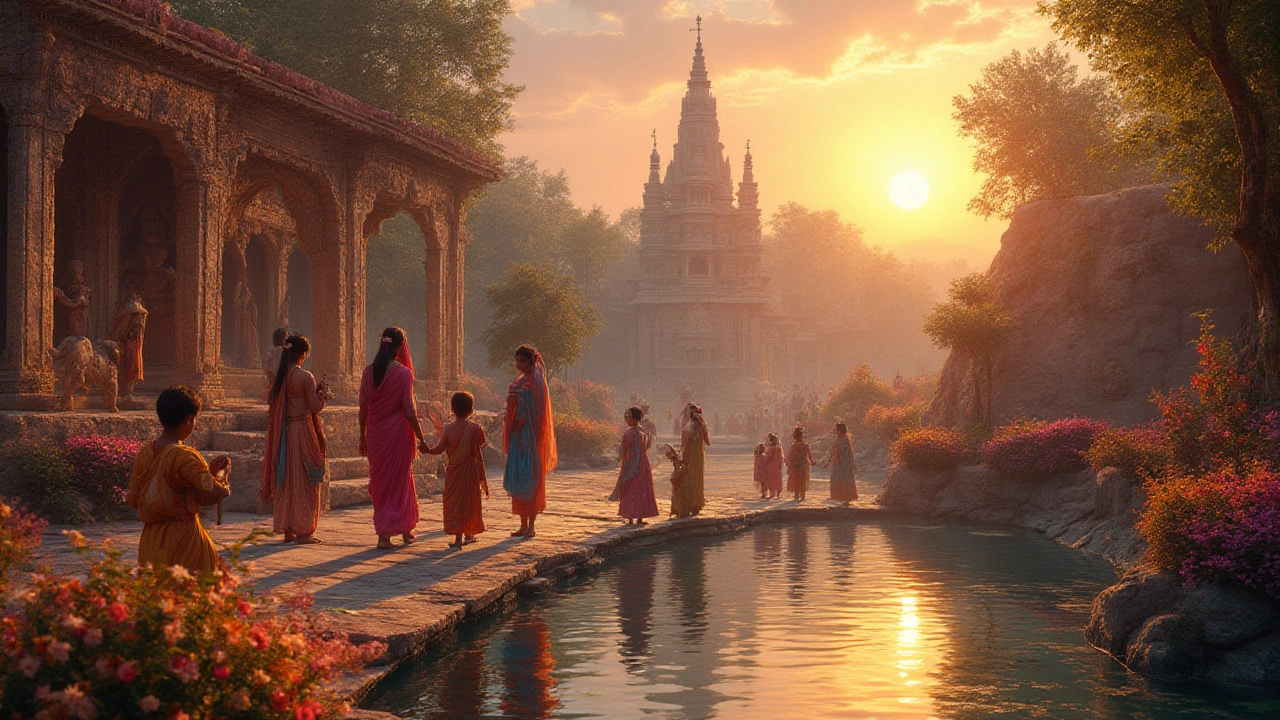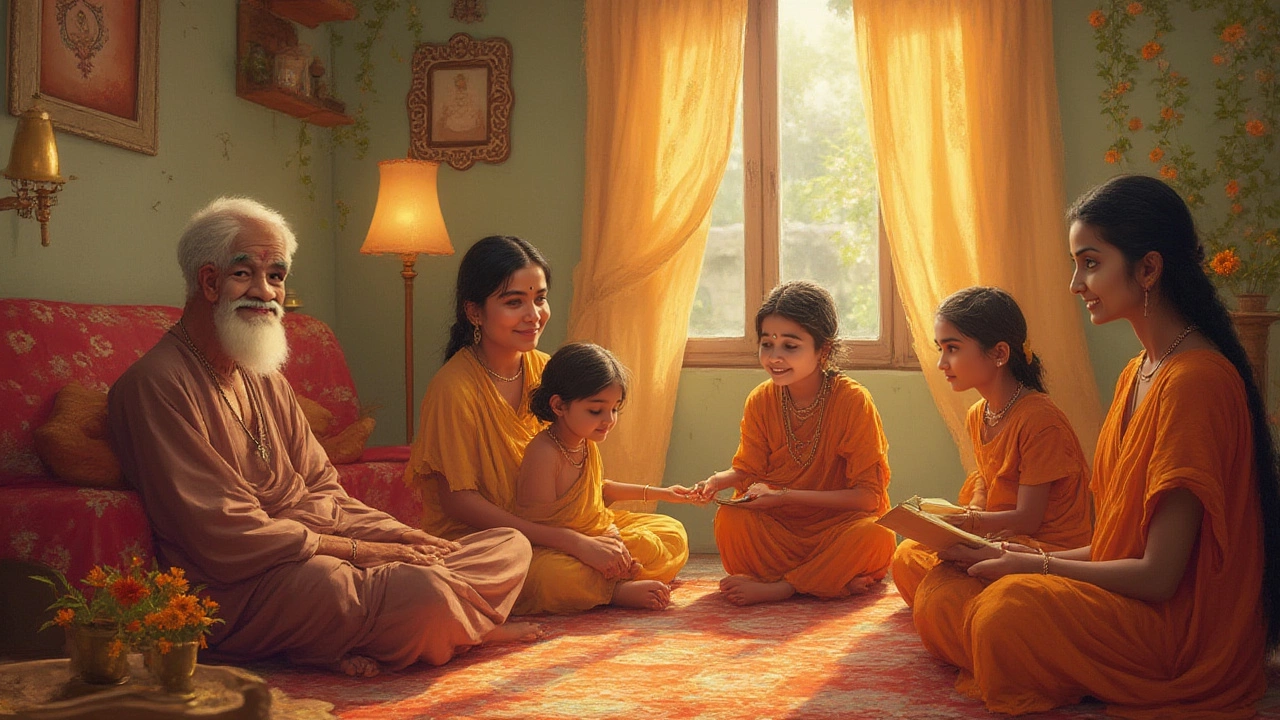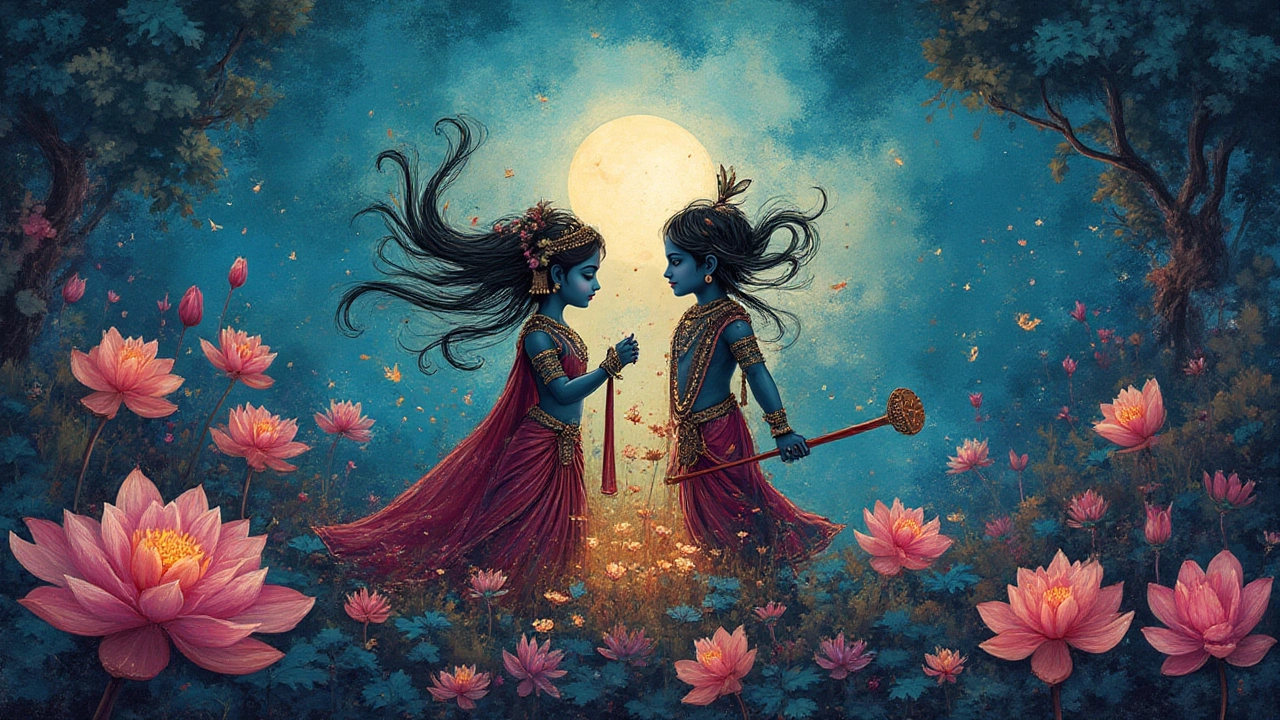How Hindus View Love: Spiritual Meanings, Stories, and Traditions
 Jul, 11 2025
Jul, 11 2025
It’s strange how love always manages to stick around in every story, isn’t it? No matter where you look, it’s in the background, making life sweet, complicated, sometimes messy. For Hindus, love isn’t just a passing emotion; it’s baked into the universe. That might sound dramatic, but it’s true. In Hindu culture, love is a force that shapes destinies, changes worlds, and challenges what’s possible. Ask anyone who's ever heard the tales of Krishna and Radha, Sita and Rama, or Parvati and Shiva — love is there, often tangled in devotion, sacrifice, longing, and faith.
Love as a Cosmic Principle in Hinduism
Most people think of love as a feeling, but for Hindus, there’s a whole philosophical world behind it. The ancient Sanskrit word “Prema” means deep, selfless love — something that isn’t just about hearts and flowers. In Hindu philosophy, love is considered the glue of the universe. Take the Vedas, some of the oldest scriptures on earth: They describe creation as an act of love. The cosmos itself came into being through a longing to share, to be connected, to not be alone.
Here’s where it gets interesting: love in Hinduism isn’t just about romance. There are actually several ways love gets explained. First, there’s “Kama,” which covers passionate or sensual love — think chemistry and attraction. Then there’s “Prema,” which is pure love, with no strings attached. “Bhakti” is next, and it’s devotion—loving God or something higher than yourself with all your heart. Finally, “Karuna” is compassion, loving everyone with kindness because, deep down, we’re all made of the same stuff.
You’ll see these ideas all over Hindu stories. The divine parents Shiva and Parvati show how love is about balance and respect, more than fireworks. Krishna and Radha, maybe the most famous lovers in Indian mythology, show that love can be sweet, playful, sometimes complicated, but always deeply spiritual. These stories aren’t just bedtime tales — they set examples for families, marriages, and even how people should relate to the world. For Hindus, embracing love in all its forms is the way to truly live.
Famous Hindu Love Stories and What They Teach
Let’s talk about some of these legendary couples. Rama and Sita from the epic Ramayana are household names. Their love wasn’t always easy — wars, kidnappings, and tests of faith kept getting in the way. What makes their bond special is loyalty. Rama goes to the ends of the earth to rescue Sita, and Sita’s devotion doesn’t waver, even when life hands her impossible choices. If you’re a kid growing up in a Hindu home, chances are, you’ve learned something about loyalty and sacrifices from these two.
But there’s a different flavor in Krishna and Radha’s story. Krishna, the blue-skinned god known for his mischief, falls deeply for Radha. But the story isn’t about two people living happily ever after. Instead, it’s about yearning, longing, and the spiritual kind of love — one that survives distance and separation. Radha becomes the symbol of a soul so devoted to God (or the beloved) that nothing can come between them. You’ll find their love in poetry, music, paintings, and dances across India. It’s emotional, raw, and lasts through the ages.
And then there’s Shiva and Parvati, the ultimate opposites-attract pair in Hindu mythology. Shiva is wild, often meditating or dancing in cemeteries, while Parvati is calm, nurturing, and grounded. Yet together, they show how love means accepting differences — not changing your partner, but growing with them. The trick, Hindu stories say, isn’t about finding someone perfect; it’s working through all the imperfections, and still coming together.
It’s not just all myth, though. Many of these stories have worked their way into how Hindus actually see and experience relationships. For example, love and marriage in Hindu culture are less about individual happiness and more about family, duty, and community. Elders often remind couples about the perseverance of Sita or the patience of Parvati. Even movies today echo these old themes — love survives, not because it’s easy, but because people choose it, sometimes again and again.

The Spiritual Side: Love, Devotion, and Bhakti
Hinduism takes love to another level with the idea of “bhakti,” which basically means loving God with total devotion. It’s not just about following rules or doing rituals — it’s more like falling in love with the divine, in your own unique way. There’s this famous example: Mirabai, a 16th-century poet and princess, who gave up everything and everyone for her love of Krishna. Her songs are full of longing, joy, and sometimes pain, but they always come back to the same point — love for God is the most powerful thing in the world. Today, her poetry is still recited in homes and temples across India.
But bhakti isn’t just for saints. Anyone can practice it, and it runs deep in everyday life. People decorate small shrines at home, offer flowers and sweets, sing devotional songs in the morning, or just share their worries with their favorite deity. It’s not about fear or obligation — it’s about building a relationship with something bigger. And Hindus often say this kind of love, when practiced honestly, spills over into everything else: you start seeing the world, people, even yourself, with more compassion and patience. Modern psychologists might call this “transcendental love” or “universal empathy,” but really, it all boils down to letting love guide your actions.
Another surprising thing: for Hindus, romantic love isn’t actually separate from spiritual love. Stories about Krishna and Radha blend romance and devotion, showing how even everyday affection can lead to higher understanding. Even acts like cooking a meal for your family, being patient in traffic, or caring for an aging parent can become a spiritual act when done with love. These ideas aren’t just old traditions either; they’re alive and well today. During major festivals like Holi or Diwali, people make time to reconnect with loved ones — because, deep down, everything good in Hindu culture is rooted in love, both human and divine.
How Love Plays Out in Hindu Daily Life and Relationships
So, what does all this look like in real life? If you visit a Hindu home, you’ll probably notice a few things: family comes first, relationships stretch beyond the nuclear family, and there’s a huge focus on respect. Parents usually play a big role in choosing partners, or at least giving their blessings. This isn’t because love doesn’t matter — it’s about finding balance between feelings and what works for the family. There’s this belief that when families come together, marriages can last longer and weather more storms. In urban areas, love marriages are on the rise, but even then, a nod from parents is a big deal.
Friendship, actually, is a hidden hero in Hindu ideas about love. If you read the Mahabharata, one of India’s greatest epics, the bond between Krishna and Arjuna is front and center. Their love isn’t romantic — it’s about trust, loyalty, and guiding each other through tough times. Many Hindu families encourage their kids to build strong friendships, not just romantic relationships. It makes sense: love, after all, is about caring for someone, even when it’s not always convenient.
Daily rituals also keep love alive. Elders bless children with a gentle touch on the head. Couples pray together in the morning. Even mealtimes become tiny celebrations of togetherness. There are dozens of festivals — Raksha Bandhan, Karva Chauth, and more — all designed to honor the bonds between siblings, parents, spouses. It’s not unusual for aunts, uncles, cousins, and even neighbors to be part of your closest circle. Love in Hindu life isn’t private; it’s shared, extended, and celebrated in every corner of the community.
Of course, no tradition is perfect. Hindus, like everyone, have their ups and downs — heartbreak, family drama, and tough choices. But the culture teaches ways to face them with resilience. If a marriage gets rough, elders might tell stories about how Sita or Parvati endured tough times. Love isn’t supposed to be effortless; it’s shaped through patience, forgiveness, and sometimes a little humor. My own daughter, Aditi, once asked why weddings are such a big deal in our family. I told her — it’s because, in Hindu life, love is the seed, but it’s everyone’s job to help it grow.

Tips and Insights on Embracing Hindu Views on Love
If you’re curious about weaving some of these Hindu ideas into your own relationships, there are a few easy places to start. First, don’t separate love from respect; in Hindu culture, they go hand in hand. Tiny acts—greeting elders every morning, sharing meals, or even sending a thoughtful message—are little doses of love that add up. Great relationships aren’t built overnight; they’re nurtured, moment by moment.
Second, take inspiration from the epic stories, but live your own love story. Sure, Rama and Sita faced huge struggles, but your daily life counts too. Celebrate the wins, forgive the mistakes, and give your relationships space to grow. If you hit a rough patch, remember everyone — even the gods — faced hard times in love and bounced back moment by moment.
Third, tap into Hinduism and love by building practices that foster connection. It might be lighting a small lamp together every evening, or making time to walk around the block and talk about your day. Maybe you sing together, or just share silly jokes. The point is to keep showing up, again and again. In my own house, my daughter Aditi and I host a “special snack time” every Sunday — it’s simple, but it makes us both feel loved.
Another tip: don’t be afraid of bringing spirituality into your relationships, even if it’s just practicing gratitude before bed, or whispering a small prayer for someone you care about. Festivals and rituals aren’t just for tradition; they can be reminders to cherish your loved ones.
And finally, if you ever feel lost or confused about love, there are stories and songs that have comforted generations before you. Read them, sing them, or just ask an elder for their favorite tale. Sometimes, our hearts need the wisdom of the old world to make sense of the new.